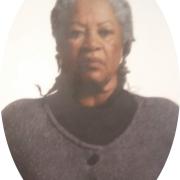Sometimes, when you’re teaching a class featuring a topic that students might be unfamiliar with, students can be nervous or hesitant at first. Shaun Myers knows this, which is why she tries to assuage those feelings by spending time talking about history at the outset of a course. So perhaps it will come as no surprise that, after a few moments of me, as green to the journalism game as they come, nervously fumbling around with my things and stammering through jumbled thoughts— Myers kicked off our interview by asking about my history.

Shaun Myers (Photo: Monica Myers)
Here’s a CliffsNotes version of hers: Myers is currently in her second year as an assistant professor of English at Pitt, specializing in African American literature. Her background reads almost literally as a roadmap: She has been an assistant professor at Northwestern; a postdoctoral fellow at Rutgers; a lecturer at the University of Maryland, College Park; and a journalist in New York. But before all that, she grew up in Cleveland Heights and completed her undergrad at Miami University of Ohio, making her arrival in Pittsburgh feel like a homecoming of sorts. “Two weeks after I graduated [from college], I started working at a newspaper in New York ... and I hadn’t been back to this part of the country in several decades," she said. "So it’s really wonderful to be here in a job that I love and to raise my family here.”
The idea of conversation is central to Myers’ courses. There’s a literal component to that, of course, but there’s also a more conceptual exploration of conversation to be had. When it comes to reading literature, Myers said that she emphasizes “the idea of intertextuality, and how authors speak to one another across time and space.” Instilling historical knowledge, then, is more than just a way to make students feel more comfortable with an idea: It’s vital to understanding how and why a conversation is unfolding. “I consider myself a professor of literature and culture. It’s always a part of my courses to think of literature not as apart from other cultural forms but in conversation with them,” she said.
As do the classes she teaches, much of Myers’ research revolves around racial identities, particularly in writing. Her dissertation, titled World Beyond Brown, examines black writers in the post-Civil Rights United States. Some of the central questions, Myers says, are: “How did a world not materialize within the U.S.—[a world] that was expected or anticipated or promised? And in what ways did African American writers cope with this lack of fulfillment of the Brown vs. Board of Education desegregation ruling?” Myers also wrote an article that’s featured in the American Literary History journal, "Black Anaesthetics: The New Yorker and Andrea Lee’s Russian Journal." According to Myers, the premise of black anaesthetics is that “blackness has so many functions in US culture; what happens when we can’t use it in the ways we’re accustomed to?” She parses out this question by examining how black women writers like Andrea Lee or Toni Morrison either integrated a writerly voice that was typically presumed to be white and male or refused to racially identify characters.

Toni Morrison, National Portrait Gallery
Whether you’re poring over Myers’ research or leafing through her syllabi, the name of the recently deceased Nobel Laureate Toni Morrison is bound to come up. Myers teaches a senior seminar class called Unbecoming Narratives: Toni Morrison in Conversation, and that feels like a perfect example of what started Myers on her path. “I can probably honestly say that Toni Morrison is the reason that I’m here today,” she said. “Growing up, I never read a piece of literature (within a classroom) by a black author until [almost] my senior year in college. When I read black literature, I had to do it on my own in a solitary place, ... never in a community of learners; those texts just weren’t assigned.”
Those texts may now be more common in classrooms, but when you take one of Myers’ classes, you can count on the learning extending beyond the confines of a classroom. “Sometimes a lecture hall is not the space for a teaching moment,” she said. “I often try to have a component in my classes where we’re not just sitting with a big Norton anthology or holding books in our hands; we’re going out to the public.” Sometimes a teaching moment means going out to see material from class out in the world. Pitt is home to the Center for African American Poetry & Poetics (CAAPP), an arm of the English department which aims to provide a place where African American writers, artists, and scholars can incubate, promote, and present their work. A few times a year, Heinz Chapel hosts various African American poets, writers, and visual artists who present their work, allowing Myers’ students to see what she calls “African American literature in public.” In addition, CAAPP offers workshops with these literary and audiovisual artists in Pittsburgh neighborhoods. Myers noted that events like these “illuminate the richness, the robustness, the liveliness of African American literature right now,” as well as helping students gain an appreciation for “how it’s surviving, and really just an animated thing that’s in our midst.”
Other times, a teaching moment means responding to an ongoing cultural development. Because Myers’ courses deal with sensitive issues, she prioritizes creating an environment that’s safe for her students. “There’s a lot to deal with in my classes, because we confront the legacy of American history. ...With the things I ask my students to read, I also have to make a space for them to be able deal with these things in their past and in their present forms,” said Myers. That’s why, the week following the 2016 Presidential Election, Myers replaced a class meeting with a day of open office hours. It might be easier to simply ignore such a contentious issue. But Myers didn’t want things to go on as usual—nor did her students. “My office was full of students that day; it was a continuous line of students coming in to talk,” she recalled. “I got to have multiple teaching moments with my students in an intimate space, which felt appropriate for the day.”
These days, in addition to American Literary History, you can find Myers’ work in publications such as Souls: A Critical Journal of Black Politics, Culture, and Society and African and Black Diaspora. Myers has a few projects in the works. She’s currently working on developing two book manuscripts: one on black anaesthetics, titled Black Anaesthetics: African American Literature Beyond Man, as well as another called Black Transit: The Aesthetics of Post–Civil Rights Movement, in which Myers examines the post-integration aesthetics of transit. Oh, and just for good measure, she’ll soon have work featured in the forthcoming Cambridge critical collection African American Literature in Transition: 1980-1990. After waiting until nearly her senior year of college to study something by a black writer in school, Myers is well on her way to having her own critical writing studied in schools.
When I interviewed Shaun Myers, she mentioned a map drawn by Langston Hughes in which he documented his many travels. She didn’t have it on hand to show me, but I imagine it looks fairly similar to the roadmap of her life. Fortunately, it sounds like Pitt will be a thick circle on hers: After a little over a year in Pittsburgh, Myers said that she’s already grown fond of the city. “I’ve become a real advocate of Pittsburgh," she said. "Not to say that it’s perfect, but I feel committed to working on what’s imperfect in this city. My family has historical roots here, so I feel doubly committed to working for a better life for all of Pittsburgh’s residents.” Considering the at times less-than-pleasant sports rivalries between Pittsburgh and Cleveland, that’s some pretty high praise.
—Nick Trizzino
Nick Trizzino is T5F’s communications intern, a senior Public and Professional Writing major, and a first-time byline writer. He’s open to suggestions on it.
